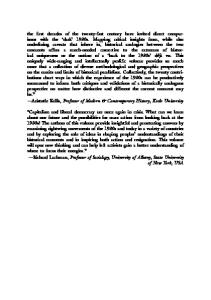The Spectre of the 1930s
How might we come to terms with the rise of authoritarianism not just in the United States and Europe but also in the Global South, in Turkey, Brazil, India, Egypt, among others? Is it helpful to think of this phenomenon in terms of the return of “fascism
- PDF / 8,913,425 Bytes
- 443 Pages / 433.701 x 612.284 pts Page_size
- 58 Downloads / 326 Views
ack to the ‘30s? “All history is contemporary history. But very few historians self-consciously explicate what this might mean. Translating the dictum into concretely focused investigations is rarer still. Pressing beyond the facile analogies and over-hasty comparisons, this finely conceived volume demonstrates carefully and persuasively how exactly Europe’s interwar crises can help us to think effectively about the present.” —Geoff Eley, Karl Pohrt Distinguished University Professor of Contemporary History, University of Michigan, USA “Breaking with the schematic and formalistic approach that dominates much of social science, this volume applies the resources of critical theory to a wide range of case studies to generate new insights into the current moment. A must read for anyone interested in contemporary politics.” —Dylan Riley, Professor of Sociology, University of California, Berkeley, USA “By juxtaposing the last decade of global politics with the decade that followed the New York Stock Exchange crash of 1929, Back to the ‘30s? piles up parallels between fascism’s golden age and the most recent rise of authoritarianism. Masterfully compiled, this book offers a compelling socio-political thesis, an exceptional collection of analyses, and a keen sensitivity to history’s most important questions. Its strong emphasis on the Global South, Eastern Europe, East Asia, Australia, and the European periphery lends it a unique force and relevance. All readers interested in the rise of international right-wing populism and neo-fascism will want this on their shelf.” —Nitzan Lebovic, Associate Professor of History, Lehigh University, USA “Comparing the 1930s to the 2010s, through a multidisciplinary approach applied to a variety of cases, this very interesting collection helps to understand today’s Gramscian Interregnum by pointing to the interrelation of specific forms of capitalist accumulation and authoritarian political turns, as well as to counter-hegemonic practices.” —Donatella Della Porta, Professor of Sociology and Political Science, Scuola Normale Superiore, Florence, Italy “Amidst the maelstrom of financial emergencies, violent institutional readjustments, hegemonic crises and exploding counter-hegemonic alternatives,
the first decades of the twenty-first century have invited direct comparisons with the ‘dark’ 1930s. Mapping critical insights from, while also underlining caveats that inhere in, historical analogies between the two moments offers a much-needed corrective to the extremes of historical uniqueness or the notion of a ‘back to the 1930s’ déjà vu. This uniquely wide-ranging and intellectually prolific volume provides so much more that a collection of diverse methodological and geographic perspectives on the merits and limits of historical parallelism. Collectively, the twenty contributions chart ways in which the experience of the 1930s can be productively summoned to inform both critiques and validations of a historically analogous perspective no matter how distinctive and different the current momen
Data Loading...











